Connecting & Configuring SPA8000 with UC500, 520, 540, 560 & CallManager Express (CCME) - Low Cost FXS Analog Ports
When it comes to connecting multiple analog phones to VoIP systems like Cisco’s Unified Communication Manager Express (CallManager Express) or UC500 series (Includes UC520, UC540, UC560), the first thing that usually comes to mind is the expensive ATA 186/188 or newer ATA 187 devices (double the price of the older 186/188) that provide only two FXS analog ports per device.
While purchasing one or two ATA devices might be acceptable for up to two or four analog phones, this quickly becomes a very expensive practice for any additional FXS ports. Thankfully, there is a cheaper solution – the Cisco Linksys SPA8000.
The Cisco SPA8000 is an 8-port IP Telephony Gateway that allows connections for up to eight analog telephones (provides 8 FXS ports) to an IP-based data network. What many engineers are not aware of is that the SPA8000 can also be configured to connect to Cisco's CallManager Express or Cisco UC500 series IP Telephony system, decreasing dramatically the cost per FXS analog port of your VoIP network.
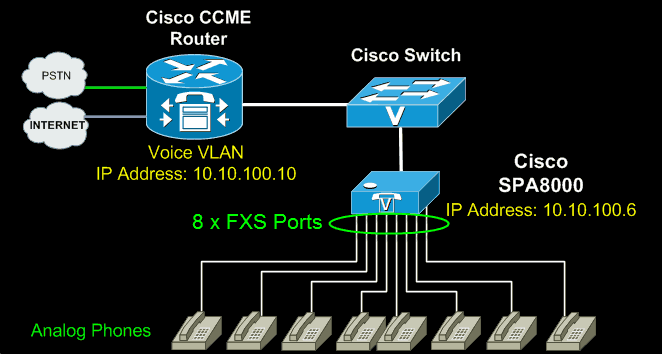
The diagram above shows the physical connection of the solution. The SPA8000, just like any VoIP device, is configured and connected to a network switch and assigned to VLAN2, the Voice VLAN in our example. By doing so, the SPA8000 is able to communicate with CallManager Express using the SIP Protocol as shown below. On the back of the SPA8000, we've connected simple analog phones to FXS ports provided. These phones can be placed in areas where there is no need for the more expensive Cisco IP Phones, usually public areas, production environments etc. Note that these analog phone devices can also be wireless analog phones.
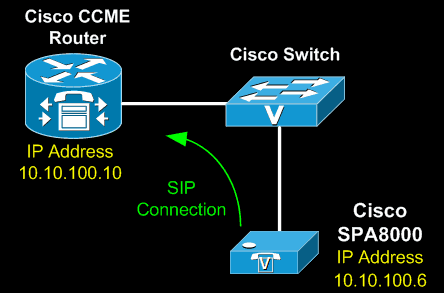
Upgrading The Cisco SPA8000 Firmware
We highly recommend upgrading the SPA8000 to the latest available firmware version. This practice usually provides new features and greater stability of the unit. This simple-to-follow process has been extensively covered in our Cisco SPA8000 Firmware Upgrade article.
Configuring The SPA8000 IP Address
To avoid network problems, it is important to ensure the SPA8000 is configured to be in the same network as the CallManager Express or UC500 – in other words, the same VLAN (Voice). In the SPA8000 Network – WAN Status tab, always ensure the Connection Type is set to Static and appropriate IP Address, Gateway and DNS Server is provided:
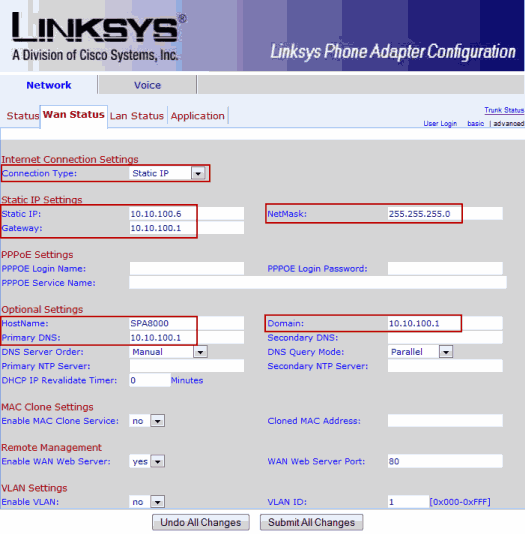
Configuring The SPA8000 FXS Ports For SIP Registration With CallManager Express / UC500, UC520, UC540, UC560
On the main Voice configuration tab, the SPA8000 lines are configured on tabs L1 through L8. To enable a line, for example L1 which corresponds to FXS port 1, click on the L1 tab and set Line Enable to YES:
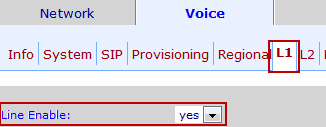
Next, we need to configure the following settings:
- Proxy: IP Address of our CCME or UC500 series IP PBX
- Register: Enable registration of the line with CallManager Express or UC500
- Make/Ans Call Without Reg: Always force the line to be registered with CCME or UC500 to place or answer a call
- Display Name: Caller ID for the extension. This is the Caller ID other extensions will see when we dial from this line
- User ID: The line’s extension number e.g 139
- Auth ID & Password: Username and password combination for this line. We use cisco / firewallcx
- Use Auth ID: Enable authentication for this line.
It is important to note that the same Auth ID & Password is used for all configured lines, that is, L1 though L8.
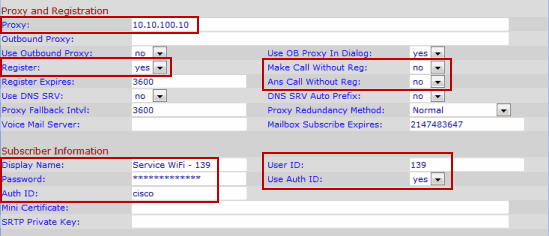
At this point, we have completed the SPA8000 configuration and are ready to move to CallManager Express or UC500 configuration.
Configuring CallManager Express & UC500 (UC520, UC540, UC560) SIP Registration For SPA8000
On the CallManager Express side, the SIP CME feature is used to register the SPA8000 as a generic SIP endpoint, allowing each configured line (on the SPA8000) to register with CCME.
First, we create a voice class codec that will define the voice codecs that can be used by CallManager Express and SPA8000:
CCME(config-class)# codec preference 1 g711ulaw
CCME(config-class)# codec preference 2 g729r8
Next, we enable the SIP registrar server on our CallManager Express:
CCME(config)# voice service voip
CCME(conf-voi-serv)# sip
CCME(conf-serv-sip)# registrar server
CCME(conf-serv-sip)# exit
Now we need to define the global voice register parameters:
CCME(config)# voice register global
CCME(config-register-global)# mode cme
CCME(config-register-global)# source-address 10.10.100.10 port 5060
CCME(config-register-global)# max-dn 10
CCME(config-register-global)# max-pool 10
The source IP Address used here is that of the CallManager Express or UC500 Voice VLAN interface.
Now configure the extension number for each FXS port on our SPA8000:
CCME(config)# voice register dn 1
CCME(config-register-dn)# number 139
CCME(config-register-dn)# no-reg
CCME(config-register-dn)# voice register dn 2
CCME(config-register-dn)# number 140
CCME(config-register-dn)# no-reg
CCME(config-register-dn)# voice register dn 3
CCME(config-register-dn)# number 141
CCME(config-register-dn)# no-reg
CCME(config-register-dn)# voice register dn 4
CCME(config-register-dn)# number 142
CCME(config-register-dn)# no-reg
CCME(config-register-dn)# voice register dn 5
CCME(config-register-dn)# number 143
CCME(config-register-dn)# no-reg
CCME(config-register-dn)# voice register dn 6
CCME(config-register-dn)# number 144
CCME(config-register-dn)# no-reg
CCME(config-register-dn)# voice register dn 7
CCME(config-register-dn)# number 145
CCME(config-register-dn)# no-reg
CCME(config-register-dn)# voice register dn 8
CCME(config-register-dn)# number 146
CCME(config-register-dn)# no-reg
Finally, we must create a registration pool for our SPA8000 lines. One pool only is required. Note that the MAC Address configured is that of our SPA8000:
CCME(config-register-dn)# voice register pool 1
CCME(config-register-pool)# id mac 687F.7459.85EC
CCME(config-register-pool)# number 1 dn 1
CCME(config-register-pool)# number 2 dn 2
CCME(config-register-pool)# number 3 dn 3
CCME(config-register-pool)# number 4 dn 4
CCME(config-register-pool)# number 5 dn 5
CCME(config-register-pool)# number 6 dn 6
CCME(config-register-pool)# number 7 dn 7
CCME(config-register-pool)# number 8 dn 8
CCME(config-register-pool)# dtmf-relay rtp-nte
CCME(config-register-pool)# voice-class codec 1
CCME(config-register-pool)# username cisco password firewallcx
CCME(config-register-pool)# no vad
The number 1 dn 1 command configures the extension assigned to Line 1/FXS Port 1. Likewise, the number 2 dn 2 command configures the extension assigned to Line 2 /FXS Port 2and so on. Lastly, note the username and password combination used for all lines.
At this point, the configuration is complete and the SPA8000 should start registering its 8 lines to CallManager Express.
Directory numbers assigned to the SPA8000 (139 through 146 in our example) should not be assigned as directory numbers to other IP Phones.
If we pick up a Cisco IP Phone and dial extension 139, the analog phone connected to Line 1 on our SPA8000 should ring.
Allowing Direct Transfers To SPA8000 Extensions
When using the SPA8000 most engineers are faced with a common problem: Incoming calls cannot be transferred to the extensions assigned to the SPA8000’s lines.
For example, we have an incoming call answered by the receptionist. The receptionist now needs to transfer the call to extension 139, so he presses the Transfer button and enters 139 and receives a beeping busy-signal, even though extension 139 is on-hook (not talking).
This is because extensions 139 through 146 are not directly registered with the Cisco CallManager system using the SCCP (Skinny) protocol as normal Cisco IP Phones usually are. Extensions 139 through 146 are registered via SIP Protocol and are handled differently.
To overcome the direct transfer limitation described, we need to instruct the CallManager Express to allow the transfer of calls to the extensions assigned to our SPA8000’s lines.
The configuration below enables direct transfers to all SIP extensions configured in our example setup:
CCME(config)# telephony-service
CCME(config-telephony)# transfer-pattern 139
CCME(config-telephony)# transfer-pattern 140
CCME(config-telephony)# transfer-pattern 141
CCME(config-telephony)# transfer-pattern 142
CCME(config-telephony)# transfer-pattern 143
CCME(config-telephony)# transfer-pattern 144
CCME(config-telephony)# transfer-pattern 145
CCME(config-telephony)# transfer-pattern 1
This completes the configuration of CallManager Express and UC500 series IP PBX systems to allow the connection and registration of Cisco SPA8000 in order to provide a cheap alternative for analog FXS ports.
Your IP address:
18.191.66.218
Wi-Fi Key Generator
Follow Firewall.cx
Cisco Password Crack
Decrypt Cisco Type-7 Passwords on the fly!













